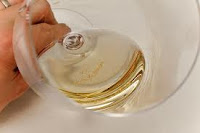If
you’ve ever opened a bottle of white wine and noticed small flakes or crystals on the bottom, these are known as wine diamonds. Also called
tartrates by those more scientifically minded, ie: winemakers.
These
‘diamonds’ are actually potassium bitartrate crystals, and occur naturally in
wine. These crystals can resemble faceted diamonds, shards of glass or
snowflakes in a bottle.
They
usually occur in white wines and are completely harmless. In fact, the wine industry has been the
largest supplier of potassium bitartrate crystals for years. You see, in
cooking, potassium bitartrate is known as Cream of Tarter!
In
Germany, these crystals are known as Weinsteins (wine stones) and are viewed as an
indication of a quality wine; One that has been fermented slowly, and crafted
from mature grapes, thereby allowing the wine’s personality to develop even
more.
While
wine diamonds do not adversely affect the wine’s quality or taste, you can find
two schools of thought about them.
There are those who believe tartrate dropout is disconcerting, they find
it unsightly, and feel that it affects the wine’s mouthfeel by making it
‘crunchy.’
Another
group views wine diamonds as an added bonus, indicating a wine that was
fermented more slowly, resulting in a better aroma and flavor.
Many
American wineries find the crystals unsightly and will cold stabilize their
wines in order to minimize tartrate dropout in the bottle. Cold stabilization is the process of cooling a wine down to
near freezing, over a short period of time, so that the tartrates fall out more
quickly. The crystals then cling to the sides and bottom of the fermentation tank and the
wine can be pumped out and filtered to remove any remaining crystals.
You
will notice wine diamonds mainly in white wine. They also occur in red wines, but not
that often and are not noticeable except at the bottom of bottle and sometimes on the wine cork.
If
you find that you have a bottle containing flakes, you have some options – one
is allow the crystals to settle to the bottom, then pour your wine carefully,
letting the diamonds settle in the shoulder of the bottle. You can also strain the wine through a
coffee filter or cheesecloth to remove the crystals.
Just
remember, this is a natural process of winemaking. Wine diamonds will not affect the flavor or spoil the
wine. At a wine festival one year,
our winery had a Chardonnay that had developed wine diamonds. When a festival attendee asked about
the flakes in the bottom of the bottle, I held it up for all to see and replied
that only the fortunate few get to enjoy a wine with true wine diamonds in it. We
sold out of Chardonnay that afternoon! (It's all in how you spin the bottle ; )
Enjoy!
~
Joy









No comments:
Post a Comment